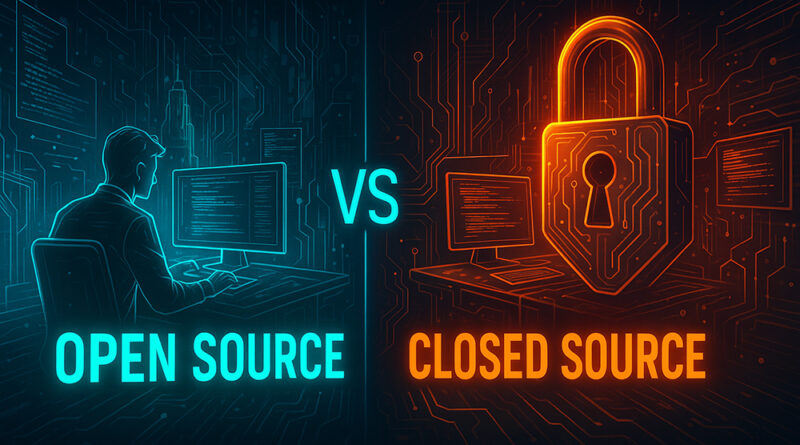Open Source vs Closed Source Software: Key Differences, Pros and Cons, and the Showdown Between OpenAI and DeepSeek
1. What Do “Open Source” and “Closed Source” Actually Mean?
-
Open source software publishes its source code—and, in the case of AI, the model weights—under licences such as MIT, Apache 2.0 or GPL. Anyone can inspect, modify, or fork the project.
-
Closed source software withholds its source code or model weights. Users interact through compiled binaries, cloud APIs or SaaS dashboards and must accept a proprietary end-user licence agreement.
At first glance the distinction looks simple. Yet the choice has profound implications for transparency, control, cost, and innovation pace.
2. Core Differences in Detail
2.1 Transparency
Open Source
Code is laid bare. Developers can audit algorithms for security holes, biases and data-handling practices. Community bug reports tend to arrive quickly, and fixes can be merged in hours.
Closed Source
Inner workings remain hidden. External researchers must rely on vendor white papers or benchmark claims. While obscurity can deter casual hackers, it also means critical vulnerabilities may linger until the vendor discloses or patches them.
2.2 Customisation and Control
Open Source
Teams can recompile the software, add bespoke plugins or fine-tune an AI model on private data. If the project direction veers away from their needs, they can fork and maintain their own version.
Closed Source
Customisation is limited to configuration settings the vendor exposes. Feature requests go through support tickets, and development priorities follow the vendor’s internal road-map, which might not align with every customer.
2.3 Security Posture
Open Source
More eyes on the code means vulnerabilities are spotted sooner, but it also gives attackers a blueprint. A strong community patch culture is paramount to stay ahead of exploits.
Closed Source
Security through obscurity offers one line of defence, yet users must trust that the vendor follows best practices. When a zero-day flaw surfaces, response speed depends entirely on the vendor.
2.4 Total Cost of Ownership
Open Source
Licence fees are typically zero, making it attractive for start-ups, researchers, and educational institutions. Costs shift to infrastructure, integration, and optional commercial support contracts.
Closed Source
Licences or subscription fees can be substantial but may bundle enterprise-grade support, uptime guarantees and compliance certifications—essential for regulated industries that cannot risk downtime.
2.5 Innovation Velocity
Open Source
Anyone can experiment and publish improvements, spawning a rapid cycle of forks, add-ons and niche optimisations. This accelerates breakthroughs but can also scatter focus across competing branches.
Closed Source
A single product team drives R&D. Breakthroughs might arrive less frequently but are often integrated into a polished ecosystem with consistent user experience.
3. Open Source: Advantages and Drawbacks
3.1 Benefits
-
Peer Review and Trustworthiness
Open code lets academics vet algorithms for ethical concerns, bias and privacy leaks, fostering greater confidence among users. -
Agility and Rapid Experimentation
Developers can spin up a fork, add a feature, or test a hypothesis overnight without waiting for a vendor road-map. -
Lower Barriers for Innovation Hubs
Universities and emerging-market start-ups can tap world-class tools without sky-high licensing costs, levelling the playing field.
3.2 Disadvantages
-
Fragmentation
Competing forks may implement incompatible changes, forcing ecosystem players to support multiple variants. -
Variable Support Quality
Community forums can be terrific but inconsistent. Enterprises may still need to purchase a support contract, erasing some cost advantages. -
Security Paradox
While open review encourages rapid patching, attackers also benefit from source-level visibility, requiring robust community governance to keep pace.
4. Closed Source: Pros and Cons
4.1 Benefits
-
Unified Product Vision
End-to-end integration—from usability to security patches—falls under one roof, producing a cohesive, polished experience. -
Proprietary Performance Lead
Vendors often invest heavily in cutting-edge research, training massive AI models or optimising kernel-level code, then monetise the exclusive advantage. -
Enterprise-Grade Service Agreements
24/7 help desks, guaranteed response times, and built-in compliance certifications reduce risk for banks, healthcare providers and government agencies.
4.2 Disadvantages
-
Vendor Lock-In
Migrating away can mean rewriting integrations, retraining staff, and sometimes paying data-export fees. -
Opaque Risk Profile
Users cannot fully verify how data is stored, processed, or shared. This is especially critical for privacy-sensitive sectors. -
Pricing Power Concentration
Once entrenched, vendors can raise fees or change terms, leaving customers with limited negotiating leverage.
5. Case Study: OpenAI vs DeepSeek
5.1 OpenAI’s Closed Ecosystem
OpenAI’s flagship GPT-4 and GPT-4o models are accessible exclusively via API. This approach prioritises:
-
Safety Controls: OpenAI can enforce content filters and usage policies centrally.
-
Monetisation: Pay-as-you-go pricing generates predictable revenue streams.
-
IP Protection: Weights stay proprietary, preventing direct replication by competitors.
5.2 DeepSeek’s Open Strategy
By contrast, China-based DeepSeek releases model weights and training code under an MIT licence. Its goals include:
-
Global Community Adoption: Developers worldwide can run the model locally, spawning downstream forks and fine-tunes.
-
Research Mind-Share: Openness attracts academic citations and external contributions, improving the model at minimal cost.
-
Geopolitical Soft Power: Publishing freely accessible models broadens China’s influence despite chip-export restrictions and the Great Firewall.
5.3 Practical Outcomes
-
Integration Flexibility: DeepSeek can be self-hosted on-premise, ideal for data-sovereign projects. OpenAI, meanwhile, offers turnkey reliability via Azure but cannot be run offline.
-
Cost Curve: DeepSeek’s community edition runs on consumer-grade GPUs, reducing entry costs. OpenAI charges per token, which scales linearly with usage.
-
Speed of Iteration: OpenAI controls update cadence; users must adopt changes on OpenAI’s timeline. DeepSeek’s forks can implement niche improvements overnight, though quality varies.
6. Which Model Fits Your Use Case?
| Scenario | Recommended Approach |
|---|---|
| Regulated Industry (Finance, Healthcare) | Closed source SaaS with robust compliance and support, unless resources exist to secure and maintain an open model in-house. |
| Academic Research & Low-Budget Prototyping | Open source provides no-cost access and deep customisability. |
| Global Consumer Application | Hybrid: fine-tune an open model for privacy, but call a proprietary API for advanced features. |
| Sensitive Intellectual Property | Self-hosted open source model keeps data in-house and avoids third-party telemetry. |
7. Future Trends to Watch
-
Hybrid Licensing Models
Companies may release smaller “research” checkpoints openly while monetising larger iterations, blending community goodwill with revenue. -
Regulatory Pressure for Transparency
Policies such as the EU AI Act could compel even closed vendors to share safety methodologies, nudging the industry toward partial openness. -
Hardware Democratization
Mid-range GPUs are becoming powerful enough to host 10-70 B parameter models locally. That shift will amplify open-source adoption when compute is no longer a gating factor. -
Unified Safety Layers
Expect both open and closed models to embed retrieval-augmented guardrails, ensuring content moderation and factual accuracy regardless of licensing stance.
8. The Bottom Line
Open source and closed source are not polar opposites but strategic choices on a spectrum. OpenAI’s closed ecosystem offers turnkey power, consistent updates and centralised governance—at a cost in dollars and transparency. DeepSeek’s open methodology democratises cutting-edge AI, inviting rapid global experimentation but placing quality-control burdens on the community.
For engineers, CIOs and policymakers, selecting between open and closed hinges on factors such as regulatory requirements, budget constraints, tolerance for vendor lock-in, and the need for rapid iteration. Understanding these levers will shape who leads the next wave of software and AI innovation—and whether that lead resides in Silicon Valley, Shenzhen, or a community GitHub repo anyone can clone.

